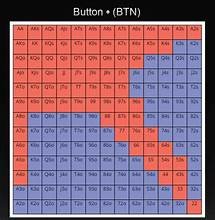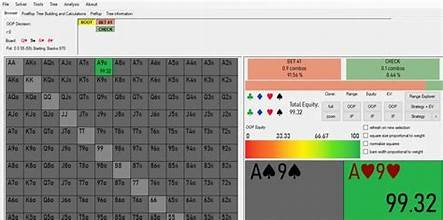IDENTIFYING HAND RANGES
IN TEXAS HOLDEM
In Texas Hold’em, mastering the art of identifying hand ranges is a critical poker strategy that separates winning players from the rest of the field. Identifying hand ranges in poker isn’t just about guessing your opponent’s cards—it’s about narrowing down the spectrum of possible hands they might hold based on their actions, position, and betting patterns. This comprehensive understanding allows you to make well-informed decisions, adjust your gameplay, and maximize your profits at the table.
Incorporating poker hand range strategy into your game gives you a significant edge. While some players rely on gut feelings or isolated tells, seasoned professionals analyze pre-flop and post-flop behavior to refine their reads. By using concepts like combinatorics and Game Theory Optimal (GTO) strategies, you can elevate your approach, balancing mathematical precision with psychological insight.
In this article, we’ll explore how to identify and adjust hand ranges from pre-flop to the river. We’ll dive into advanced techniques, common pitfalls, and even how AI tools and solvers are revolutionizing hand range analysis. Whether you’re a novice looking to strengthen your fundamentals or an experienced player aiming to refine your strategy, this guide will provide the depth and nuance needed to stay ahead in the game.
WHAT IS A HAND RANGE?
A hand range in Texas Hold’em refers to the collection of possible hands that an opponent could hold in a given situation. Instead of trying to pinpoint one exact hand, successful players assign a spectrum of potential hands based on an opponent’s betting patterns, position at the table, playing style, and game dynamics. This approach allows you to make more informed decisions as you’re evaluating a set of possibilities rather than a single outcome.
NARROW RANGE
WIDE RANGE
A player with a narrow range typically holds strong, premium hands. For example, a player raising from an early position might have a narrow range consisting of pocket Aces, Kings, Queens, or Ace-King suited.
A player with a wide range could have a variety of hands, from strong holdings to speculative ones like suited connectors or weak aces. For instance, a late-position player might raise with a broader spectrum of hands, including lower pocket pairs, suited connectors, and even bluffs.
HOW PLAYER TYPES INFLUENCE HAND RANGES
lOOSE/pASSIVE pLAYERS
TIGHT/PASSIVE PLAYERS
TIGHT/AGGRESSIVE PLAYERS
LOOSE/AGGRESSIVE PLAYERS
These players tend to call frequently and rarely raise, leading to broader and often weaker hand ranges. They might limp into pots with hands like suited connectors, weak aces, or even low off-suit cards.
Often referred to as “nits,” these players only play premium hands and are cautious with their bets. Their hand range is narrow, focusing on strong holdings like high pocket pairs and top-tier Broadway cards.
These players are selective with their hands but aggressive in their play. Their range is tight, but they use strong betting patterns to maximize value and pressure opponents.
Known for their unpredictable style, these players have wide ranges and frequently bluff or semi-bluff. Their range can include anything from premium hands to speculative holdings, making them challenging to read.
Understanding these player types helps you assign more accurate hand ranges, leading to better decision-making in every hand.
THE ROLE OF COMBINATORICS
Combinatoricsis the mathematical study of counting and combinations, and it plays a crucial role in refining hand ranges. By understanding how many combinations of certain hands exist, you can better assess the likelihood of your opponent holding specific cards. For example, there are six possible combinations of pocket Queens but sixteen combinations of Ace-King (suited and unsuited), making it statistically more likely for an opponent to have Ace-King.
While we won’t delve too deeply into combinatorics here, you can check out our full article on Pokerrailbird.com for an in-depth exploration of how this mathematical concept refines hand range analysis.
EXAMPLES OF HAND RANGES IN DIFFERENT POSITIONS
EARLY POSITION
MIDDLE POSITION
LATE POSITION
Players in early positions tend to have tighter, stronger ranges, including premium pairs and high-value Broadway cards.
As you move to middle position, the range slightly widens to include more suited connectors and medium pocket pairs.
Players in late position often have the widest ranges, incorporating speculative hands like suited connectors, one-gappers, and weaker aces.
By understanding these foundational concepts, you can start to assign realistic hand ranges to your opponents, giving you a strategic edge in Texas Hold’em.
WHY HAND RANGES ARE IMPORTANT
Identifying hand ranges in Texas Hold’em is not just a theoretical exercise—it’s a practical skill that directly impacts your decision-making at the table. Understanding your opponent’s possible holdings allows you to make more strategic moves, increasing your chances of winning both in the short and long term.

MAKING WELL-INFORMED DECISIONS
DETERMINING HAND STRENGTH
When you can accurately estimate an opponent’s hand range, you’re better equipped to decide whether to call, fold, or raise. For instance, if you deduce that your opponent has a narrow, strong range, you might fold marginal hands that you would otherwise consider playing. Conversely, recognizing a wide range filled with weaker hands might encourage a well-timed bluff or an aggressive raise.
Hand ranges help you gauge whether an opponent is likely to have a strong made hand, a drawing hand, or complete air (nothing). This knowledge is invaluable when deciding how to proceed in a hand. For example, if the board is showing potential straight or flush draws, knowing your opponent’s tendency to play speculative hands can help you determine if they’re chasing a draw or already have a made hand.
ANTICIPATING OPPONENT REACTIONS
ADAPTING YOUR STRATEGY
By understanding hand ranges, you can predict how opponents will respond to different betting patterns. If you identify that a tight player is likely holding a premium hand, you might avoid unnecessary confrontations. On the other hand, if you know a loose/aggressive player has a wide range, you can set traps or induce bluffs, keeping them off balance.
Poker is a dynamic game, and hand ranges aren’t static. They evolve based on the stage of the hand and your opponent’s behavior. By consistently updating your assessment of an opponent’s range, you can adjust your strategy to exploit weaknesses and capitalize on opportunities.
KEEPING YOUR GAME UNPREDICTABLE
Just as you analyze your opponents’ ranges, they are doing the same to you. By varying your own range—sometimes playing unexpected hands or altering your betting patterns—you can keep opponents guessing. This unpredictability prevents them from accurately pinning you on a specific range, giving you a strategic edge.
However, it’s crucial to note that unpredictability should never come at the expense of mathematical correctness. Playing hands that are statistically unprofitable just to “mix it up” is a surefire way to lose money. There are plenty of opportunities to vary your play while staying within the bounds of solid, math-based decisions. Deviating from mathematical fundamentals in the name of unpredictability is essentially setting your money on fire.
It’s also important to consider the stakes and skill level of your opponents. At lower stakes, where most players are recreational and not overly attentive, mixing up your play may not even be necessary. Many opponents won’t notice if you’re playing patiently with strong hands, and trying to mix it up could introduce unnecessary risk. In fact, consistently playing solid, mathematically sound hands often goes unnoticed in these games, allowing you to exploit the field without overcomplicating your strategy.
A REAL LIFE EXAMPLE
A few nights ago, I was in a game where I hadn’t played a single hand for over an hour—literally folding every hand because they were unplayable. When I finally picked up pocket Kings, there was a $15 raise with three callers ahead of me. I reraised to $45, and it still went five ways to the flop. I even joked out loud, “Apparently, no one has noticed that I haven’t played a hand in over an hour,” and still—no one picked up on it. This shows how, at lower stakes, players simply aren’t paying attention to your patterns, making complex “mixing it up” strategies unnecessary.
Mastering the skill of identifying hand ranges is essential for long-term success in Texas Hold’em. It blends mathematical precision with psychological insight, transforming you from a reactive player into a proactive strategist.
HAND RANGES: PRE-FLOP
Understanding hand ranges pre-flop is the foundation of strategic play in Texas Hold’em. Pre-flop decisions set the tone for the entire hand, and identifying an opponent’s likely range at this stage allows you to make more accurate predictions and adjustments as the hand progresses. Several key factors influence pre-flop hand ranges, including position, playing style, pre-flop actions, number of players, and the stage of the game.
KEY FACTORS INFLUENCING PRE-FLOP HAND RANGES
POSITION
Position is one of the most critical factors in determining hand ranges. Players in early positions (UTG, UTG+1) typically have tighter ranges, consisting of premium hands like high pocket pairs and strong Broadway cards. In contrast, players in late positions (cutoff, button) can afford to play a wider range, including suited connectors, one-gappers, and speculative hands, as they have more information on how the table is acting.
OPPONENT'S PLAYING STYLE
The type of player you’re facing significantly affects their pre-flop range. Tight players will have a narrower, stronger range, while loose players will include a broader spectrum of hands. Aggressive players are more likely to raise with marginal hands, whereas passive players will call or limp with a wider range but rarely raise without strong holdings.
PRE-FLOP ACTION
NUMBER OF PLAYERS
STAGE OF THE GAME
How a player behaves pre-flop—whether they raise, call, limp, or re-raise—provides valuable clues about their range. A pre-flop raise from an early position usually indicates strength, while a call might suggest a drawing hand or speculative hand.
The more players in a hand, the tighter your range should be, as the likelihood of someone holding a strong hand increases. Conversely, in heads-up situations, you can expand your range, knowing fewer opponents need to be considered.
In early stages of a tournament or cash game, players often stick to tighter ranges. As the game progresses and blinds increase, ranges tend to widen as players take more risks to accumulate chips.
ADJUSTING PRE-FLOP RANGES BASED TO PLAYER TYPE
Recognizing the type of player you’re up against allows you to refine your pre-flop range estimation further. Here’s how different player types influence pre-flop decisions.
LOOSE/PASSIVE PLAYERS
TIGHT/PASSIVE PLAYERS
TIGHT/AGGRESSIVE PLAYERS
LOOSE/AGGRESSIVE PLAYERS
These players tend to call frequently and rarely raise, which means their pre-flop range is wide and often includes weak hands. When they do raise, it’s usually a sign of strength, so adjust accordingly by tightening your calling range.
These players only enter pots with premium hands. If they raise pre-flop, it’s a strong indicator they’re holding a top-tier hand like pocket Aces, Kings, or Queens. You can exploit them by stealing blinds more aggressively when they’re not involved in the pot.
These players are selective with their hands but will play them aggressively. Their pre-flop raises are often strong, but they also mix in bluffs occasionally. Be cautious when calling their raises, but look for opportunities to re-raise when you sense weakness.
LAG players raise and re-raise with a wide range of hands, including speculative ones. Their unpredictable style means you should be prepared to call or re-raise more frequently with strong hands, knowing their range is broad.
ADAPTING TO TABLE DYNAMICS
Beyond individual player tendencies, the overall dynamics of the table should guide your pre-flop decisions. If the table is playing tight—where players are folding frequently and only entering pots with premium hands—you can afford to loosen your range slightly, taking advantage of the opportunity to steal blinds and control the action. Conversely, if the table is loose and players are frequently calling or raising with weak hands, it’s wise to tighten your range, focusing on strong, value-driven hands. This adjustment allows you to ‘mix it up’ while still adhering to sound, mathematically correct principles, capitalizing on the table’s general tendencies without exposing yourself to unnecessary risk.

EXAMPLE CHARTS SHOWING PRE-FLOP RANGES
Visual aids like pre-flop range charts can help you understand the typical hand ranges for different positions. These charts show which hands are generally considered playable from early, middle, and late positions, providing a solid framework for your pre-flop decisions
A WORD OF CAUTION ON GTO STARTING HAND CHARTS
While GTO starting hand charts, like those from GTO Wizard, can provide valuable guidance, it’s important to use them with caution. These charts are predominantly designed for heads-up play against opponents who are also playing GTO-correct poker—a scenario that is more theoretical than practical, especially in live cash games. For example, GTO Wizard suggests playing hands like King-Five suited from under the gun, which may be mathematically sound in a heads-up GTO environment but is a recipe for disaster in a nine-handed live cash game. Remember, these charts are tools, not rules. They offer a framework, but the best players adapt their strategy to the unique dynamics of each game they play.
Mastering pre-flop hand ranges is the first step toward becoming a strategic, adaptable player. By considering position, opponent type, table dynamics, and pre-flop action, you can make more informed decisions that set you up for success throughout the hand.
ADJUSTING HAND RANGES POST-FLOP
Identifying and adjusting hand ranges post-flop is a critical skill in Texas Hold’em, as the community cards provide new information that reshapes the potential holdings of your opponents. While pre-flop play gives you a broad foundation, the flop, turn, and river allow you to refine your reads based on how the hand unfolds. Here’s how to adjust your hand range assessments after the flop.
ANALYZING THE FLOP
WET FLOPS
DRY FLOPS
Boards with connected cards or multiple suited cards increase the likelihood of straight and flush draws. For example, a flop like 8♥ 9♥ J♠ is highly coordinated, making draws more probable.
Disconnected flops like K♣ 7♠ 2♥ are less likely to connect with a wide range of hands. This makes it easier to identify whether an opponent is holding a strong hand or is likely bluffing.
OPPONENT REACTIONS & BET-TIMING TELLS
In no-limit poker, actions often mean the opposite of what a superficial interpretation might suggest. A novice might assume that a quick bet indicates strength and a delayed bet signals weakness or indecision. However, in no-limit games where deception is key, mediocre players often bet quickly when bluffing and take longer when value betting. Skilled players, on the other hand, will disguise their hand strength by balancing the time it takes them to act, making it harder to read their intentions.
Bet-timing tells are among the most consciously controlled behaviors at the table, introducing more complexity and potential for misdirection. To navigate this, it’s crucial to consider both the timing of an opponent’s actions and their known playing style. Here are some common tendencies.
THE DELIBERATE CHECKER
THE QUICK CHECKER
THE TRICKY PLAYER
A player who often takes a long time before checking a weak hand may be trying to give the impression that they have something to consider, possibly inducing a call.
Another player might always check quickly, regardless of hand strength, to avoid giving away any tells. This consistent behavior can make it difficult to read their range.
Some players will take a long time to check strong hands, attempting to induce action from opponents who interpret the delay as a sign of weakness—a false tell designed to mislead.
The most important thing to consider is a player’s known style and their motivations within the hand. Players often adjust the length of time they take to act based on what they are trying to accomplish. Always ask yourself: What are they trying to achieve by acting quickly or taking their time?
TRACKING PRE-FLOP ACTIONS
Connecting your opponent’s pre-flop behavior to their post-flop actions helps refine their range.
Pre-Flop Aggressors: If your opponent raised pre-flop, they might be holding strong hands like high pocket pairs, premium Broadway cards, or suited connectors. Post-flop aggression may indicate they’ve connected with the board or are simply continuation betting. Many players follow the “rules” that say to always continuation bet, regardless of their actual hand strength. Be aware that a continuation bet isn’t necessarily a sign of strength. This is where opponent behavioral tells—such as changes in timing, betting patterns, or demeanor—can provide critical insights into whether they truly have a strong hand or are just following standard strategy.
Pre-Flop Callers: Players who called pre-flop might have speculative hands like suited connectors, low pocket pairs, or medium-strength Broadway cards. Their post-flop actions can reveal if they’ve hit the board or are chasing draws.
ADJUSTING FOR GAME DYNAMICS
POSITIONAL CONSIDERATIONS
Table dynamics continue to play a role post-flop. If the table is tight and cautious, aggressive post-flop bets can exploit opponents who are hesitant to continue without strong hands. In loose games, expect more calls on draws and marginal hands, requiring stronger holdings to apply pressure.
Position remains crucial post-flop. Players in early positions are more likely to bet strong hands, while late-position players might bluff or float (call with the intention of betting later). Use positional context to interpret betting patterns and refine hand ranges.
Mastering post-flop hand range adjustments requires careful observation, an understanding of board texture, and a solid grasp of opponent tendencies. By continuously refining your range assessments as each card is revealed—and incorporating tools like combinatorics and behavioral analysis—you can make more strategic decisions that enhance your long-term success at the poker table.
ADVANCED TECHNIQUES FOR REFINING HAND RANGES
As your understanding of hand ranges deepens, incorporating advanced techniques can elevate your game further. These strategies focus on balancing your own ranges, exploiting opponent tendencies, and using deceptive tactics to manipulate how others perceive your hand strength.
POLARIZED RANGES
MERGED RANGES
A polarized range consists of either very strong hands or complete bluffs, with little in between. This strategy is often used when making large bets or raises, forcing opponents to guess whether you’re holding a monster or nothing at all. For example, if you’re three-betting pre-flop, your range might include hands like A♥A♥, K♠K♠, and bluffs like A♣5♣ suited.
A merged range includes strong hands, medium-strength hands, and bluffs, making it harder for opponents to put you on a specific hand strength. This approach is useful when you want to apply pressure across a broader spectrum of hands, keeping opponents off balance. For example, flat-calling in position with hands like A♦J♦, 10♥9♥ suited, and 6♠6♠ would merge your range and prevent opponents from easily narrowing it.
EXPLOITING OPPONENTS
Once you’ve identified your opponent’s tendencies and hand ranges, you can adjust your strategy to exploit their weaknesses.
AGAINST TIGHT PLAYERS
AGAINST LOOSE PLAYERS
When facing players with narrow ranges, you can exploit them by applying pressure with a wider range of hands, especially in position. They’re more likely to fold marginal hands, allowing you to steal pots without strong holdings.
Loose opponents play a wide variety of hands, making it difficult to pinpoint their range. To exploit them, tighten your range and focus on value betting with strong hands. Avoid excessive bluffing, as they’re more likely to call with weaker holdings.
DISGUISING YOUR HAND
Advanced players use various techniques to manipulate how opponents perceive their hand strength, adding another layer of complexity to the game.
SLOW PLAYING
OVER-BETTING
CHECK-RAISING
Occasionally, underplaying strong hands by checking or calling instead of betting can induce opponents to bluff or overcommit with weaker hands.
Making unusually large bets can confuse opponents about your range, leading them to make mistakes in their decision-making.
This aggressive move can represent both strength and bluffs, making it a powerful tool when used selectively.
ADVANCED TECHNIQUES & MATHEMATICAL CORRECTNESS
While these advanced techniques—balancing ranges, exploiting opponents, and disguising your hand—are powerful tools, it is crucial to emphasize that they should never come at the expense of mathematically correct play. Poker is a game of incomplete information, but your decisions should always align with solid fundamentals like pot odds, expected value, and correct bet sizing. This is one of the shortcomings of GTO theory: while it offers a balanced theoretical framework, it doesn’t always translate effectively to live cash games, especially in multi-way pots where someone is almost always likely to call. In these real-world scenarios, deviating from sound mathematical principles in the name of exploiting ranges can lead to consistent losses. The key is to blend strategic adjustments with unwavering adherence to the mathematical truths that underlie every winning poker strategy.
By incorporating these advanced techniques into your gameplay, you can refine your hand range analysis, exploit opponents more effectively, and maintain unpredictability at the table. The key is to balance deception with solid, math-based strategies to ensure long-term success in Texas Hold’em.
THE ROLE OF ARTIFICIAL INTELLIGENCE & TECHNOLOGY IN IDENTIFYING HAND RANGES
Advancements in technology and artificial intelligence (AI) have transformed how players study and apply hand range strategies in Texas Hold’em. AI tools and solvers offer unparalleled insights into optimal play, helping players refine their understanding of hand ranges and improve their decision-making both online and in live games.
AI-driven solvers like PioSolver, GTO Wizard, and PokerSnowie have revolutionized how players analyze hands and develop strategies. These solvers simulate countless poker scenarios, using complex algorithms to calculate Game Theory Optimal (GTO) solutions—the mathematically balanced way to play each hand.
PIOSOLVER
GTO WIZARD
POKERSNOWIE
This powerful tool allows players to input specific hand scenarios and receive detailed output on optimal betting patterns, hand ranges, and equity calculations. It breaks down complex decisions, helping players understand why certain plays are optimal.
While primarily designed for heads-up and GTO-correct scenarios, GTO Wizard helps players understand range balancing and exploitative opportunities. However, as discussed earlier, its charts and strategies should be applied cautiously in live multi-way cash games, where deviations from GTO are often necessary.
Known for its user-friendly interface, PokerSnowie provides real-time feedback and hand evaluations, making it an excellent tool for players of all levels looking to improve their understanding of hand ranges.
GTO CONCEPTS: GAME THEORY OPTIMAL STRATEGIES & HAND RANGE BALANCING
GTO is a theoretical framework that aims to create a perfectly balanced strategy, making it impossible for opponents to exploit you. By understanding GTO principles, players can:
BALANCE THEIR RANGES
IDENTIFY EXPLOITATIVE OPPORTUNITIES
IMPROVE DECISION-MAKING
Ensuring that they mix strong hands with bluffs to avoid becoming predictable.
While GTO aims for balance, real-world games often present opportunities to exploit opponents who deviate from optimal play.
GTO principles guide players in making mathematically sound decisions, particularly in heads-up or short-handed scenarios.
However, it’s important to remember that GTO is just one tool in your arsenal. While it offers valuable insights, real-world poker—especially in live cash games—requires adaptability and an understanding of your opponent’s tendencies.
APPLICATION IN LIVE & ONLINE GAMES
The insights gained from AI tools and GTO solvers can be applied to both online and live poker, though the approach differs slightly depending on the environment.
ONLINE GAMES
LIVE GAMES
Online poker offers a wealth of data through hand histories and tracking software. AI tools can analyze this data to identify patterns, refine hand ranges, and suggest optimal strategies. Additionally, heads-up displays (HUDs) provide real-time statistics on opponents, helping players adjust their hand range assessments on the fly.
In live settings, while you don’t have access to tracking software, the principles learned from AI tools can still inform your decisions. Understanding GTO concepts and hand range balancing helps you recognize optimal play scenarios, even if you adjust for the human elements of live poker—like body language, bet sizing tells, and table dynamics.
It’s crucial to strike a balance between relying on AI-generated strategies and adapting to the unique dynamics of each game. While technology provides powerful tools for analysis and improvement, the ability to read opponents, understand the flow of the game, and make situational adjustments remains paramount in live poker.
By leveraging AI and technology, players can gain a deeper understanding of hand ranges, refine their strategies, and stay competitive in an increasingly sophisticated poker landscape. However, the best results come from blending these technological insights with real-world experience and sound, mathematically correct play.
COMMON MISTAKES WHEN IDENTIFYING HAND RANGES
Understanding and identifying hand ranges in Texas Hold’em is a powerful tool, but many players fall into recurring pitfalls that can undermine their strategic decisions. Recognizing these common mistakes will help refine your hand-reading skills and lead to more accurate assessments at the table.
OVER-RELIANCE ON PAST HANDS
One of the most frequent errors is relying too heavily on an opponent’s past behavior without considering the current game context. While historical tendencies can provide valuable insights, poker is a dynamic game. Skilled players adjust their strategies to stay unpredictable, meaning an opponent who played passively in the past might shift to a more aggressive approach in the present. Each new hand should be evaluated on its own merits, considering recent behavior, table dynamics, and situational factors.
FOCUSING ON SPECIFIC HANDS INSTEAD OF RANGES
IGNORING BOARD TEXTURE
Another common mistake is trying to pinpoint an exact hand rather than thinking in terms of ranges. It’s tempting to convince yourself that an opponent must have a specific hand—like a flush or a straight—based on the board and their betting patterns. However, this narrow thinking can lead to costly errors. Instead, consider the spectrum of hands your opponent might have and weigh the probabilities accordingly. By focusing on ranges, you’ll make more balanced and informed decisions.
Board texture—the arrangement of community cards—is a critical factor in hand range analysis that many players overlook. The community cards significantly influence the likelihood of certain hands being in your opponent’s range.
Wet Boards: Boards with connected or suited cards (e.g., 8♥ 9♥ J♠) increase the probability of straight and flush draws.
Dry Boards: Disconnected boards (e.g., K♣ 7♠ 2♥) are less likely to improve speculative hands, narrowing the range of strong hands your opponent could have.
Failing to consider how the board interacts with your opponent’s likely holdings can lead to misreads and poor decisions.
FAILING TO ADJUST POST-FLOP BASED ON NEW INFORMATION
OVER-ADJUSTING TO SHORT-TERM RESULTS
Some players make the mistake of sticking rigidly to their pre-flop hand range assumptions, even as new information becomes available post-flop. The flop, turn, and river provide crucial insights that should refine your initial read. If an opponent suddenly shows aggression on a dry board or slows down on a coordinated one, these actions should prompt you to reassess their range. Poker is a game of constant adaptation, and failing to adjust can leave you vulnerable to both bluffs and value bets.
Another common pitfall is becoming overly results-oriented—making strategic changes based on the outcome of a few hands rather than sound reasoning. For example, if you correctly identify an opponent’s range but they hit a lucky river card, it’s easy to second-guess your decision-making. However, poker is a long-term game, and even the best decisions can lead to bad outcomes in the short run. Trusting your process and focusing on making consistently correct decisions based on hand ranges will yield positive results over time.
NEGLECTING THE IMPACT OF PLAYER TYPES & TABLE DYNAMICS
FAILING TO RECOGNIZE WHEN OPPONENTS DEVIATE FROM GTO PLAY
Many players overlook how different player types and table dynamics influence hand ranges. For example, a tight player’s range will differ significantly from that of a loose, aggressive opponent. Similarly, if the table is generally playing tight, you can adjust your range to be more aggressive. Conversely, if the table is loose and wild, you’ll want to tighten your range and focus on value betting. Ignoring these factors can lead to misreading situations and missing opportunities to exploit your opponents.
While GTO provides a solid theoretical foundation, many players—especially in live games—deviate from these optimal strategies. Assuming that all players are adhering to GTO principles can lead to inaccurate range assessments. Recognize when opponents are playing exploitably and adjust your strategy to take advantage of their deviations.
By avoiding these common mistakes and focusing on a balanced approach that considers hand ranges, board texture, player tendencies, and game dynamics, you’ll enhance your ability to make profitable decisions at the poker table. Remember, hand reading is both an art and a science, and continuous improvement in this area is key to becoming a winning player.
UTILIZING STATISTICS TO NARROW HAND RANGES
Incorporating statistical data into your hand range analysis can significantly enhance your ability to read opponents and make informed decisions in Texas Hold’em. While intuition and observation are valuable, leveraging specific metrics provides a more objective foundation for narrowing down an opponent’s possible holdings. Here are some key statistics to consider when refining hand ranges.
VOLUNTARILY PUT CHIPS IN POT (VPIP)
PRE-FLOP RAISE (PFR)
THREE-BET FREQUENCY
VPIP measures how often a player voluntarily invests chips into the pot pre-flop, either by calling or raising. This statistic provides a clear indication of a player’s overall looseness or tightness.
High VPIP: Indicates a loose player who enters many pots, suggesting a wider and weaker range.
Low VPIP: This signifies a tight player who only plays premium hands, resulting in a narrower, stronger range.
By observing VPIP, you can quickly gauge whether an opponent is playing a broad spectrum of hands or sticking to a selective range.
PFR reflects how often a player raises pre-flop, offering insights into their level of aggression.
High PFR: Suggests an aggressive player who frequently raises, potentially with a wide range of hands, including bluffs.
Low PFR: Indicates a more passive player who seldom raises pre-flop, often signaling stronger, value-oriented hands when they do.
Comparing VPIP and PFR can reveal valuable information. For instance, a player with a high VPIP but low PFR is likely loose-passive, entering many pots but rarely with strong hands.
Three-bet frequency measures how often a player re-raises before the flop. This statistic helps identify players who are particularly aggressive and willing to challenge initial raisers.
High Three-Bet Frequency: Points to a player who is comfortable re-raising with a wide range of hands, including speculative holdings and bluffs.
Low Three-Bet Frequency: Suggests a more conservative player who only three-bets with premium hands like Aces, Kings, or Queens.
When analyzing three-bet frequency, also consider how often these players fold to further aggression post-flop. A player who frequently three-bets but folds to a continuation bet may be bluffing more often than it appears.
A HEADS-UP DISPLAY (HUD) (USEED IN ONLINE POKER)
In online poker, HUDs provide real-time statistical data on opponents, offering a significant edge in hand range analysis. HUDs display metrics like VPIP, PFR, and three-bet frequency directly on the table, allowing you to adjust your strategy on the fly.
While HUDs are incredibly useful online, it’s important to translate this statistical knowledge to live games, where such tools aren’t available. Pay close attention to opponents’ tendencies and betting patterns to gather similar insights manually.
INTERPRETING BET SIZING PATTERNS
Bet sizing is another critical statistic that can help refine hand ranges. Observing how much a player bets in different situations can reveal a lot about their hand strength and strategy.
Large Bets: Often indicate strong hands or attempts to intimidate opponents into folding.
Small Bets: May suggest weaker hands, drawing hands, or attempts to induce raises from opponents.
By tracking bet sizing patterns over time, you can identify tendencies and adjust your hand range assessments accordingly.
COMBINING STATISTICS WITH OBSERVATIONAL SKILLS
While statistics provide valuable insights, they should be used in conjunction with observational skills and game context. No single metric can paint a complete picture, but when combined with player tendencies, table dynamics, and board texture, they offer a powerful tool for narrowing hand ranges.
For example, if an opponent with a low VPIP suddenly raises from an early position, you can reasonably assume they have a premium hand. Conversely, if a player with a high three-bet frequency re-raises you from the button, their range might include a mix of strong hands and bluffs.
By integrating statistical analysis into your poker strategy, you’ll enhance your ability to accurately identify hand ranges, make better decisions, and ultimately increase your profitability at the table.
FINAL THOUGHTS
Mastering the art of identifying and adjusting hand ranges is fundamental to becoming a successful Texas Hold’em player. This skill blends mathematical principles, psychological insight, and observational acuity, providing a robust framework for making informed decisions at every stage of a hand.
Throughout this article, we’ve explored how to analyze hand ranges pre-flop and post-flop, adjust for opponent tendencies, and leverage advanced techniques like combinatorics and AI tools. Whether you’re applying statistical data from online play or reading subtle behavioral cues in live games, the key is to maintain a balanced approach that combines logic with adaptability.
It’s important to remember that while exploiting hand ranges can provide a significant edge, your strategies should always be grounded in mathematically correct play. Deviation from fundamental poker math—even in the name of “mixing it up” or exploiting opponents—can lead to long-term losses. This is particularly true in live cash games, where players often deviate from theoretical frameworks like GTO, making it essential to stay flexible while adhering to sound principles.
Poker is a dynamic game, and no two situations are ever exactly the same. Continuous learning, practice, and refinement of your hand range analysis will set you apart from less experienced players. The most successful players are those who can adapt to changing conditions while remaining disciplined in their decision-making process.
By combining a strong understanding of hand ranges with careful observation and mathematical rigor, you can elevate your game, make more profitable decisions, and ultimately become a formidable force at the poker table.









